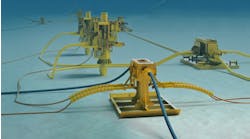Offshore staff
LONDON – Salamander Energy has commissioned a front-end engineering design (FEED) study to assess options for expanding production infrastructure of its Bualuang field in the Gulf of Thailand. This could involve adding more platforms.
Salamander hopes to obtain sanction for a next phase of development by mid-2014, with first production from the new infrastructure in 2016.
Once the new facilities are in place, output from Bualuang is expected to exceed 15,000 b/d of oil.
This summer conversion should be completed of theNavion Clipper to the Suksan SalamanderFSO, leading hopefully to a $20-25 million/yr reduction in operating costs at Bualuang.
The company aims to add more well slots on the Bravo platform and drill five dual-lateral production wells to increase the number of production drain points per slot.
In the G4/50 offshore Thailand license, drilling of prospects in the central and southern area had to be halted after the government rejected Salamander’s environmental impact assessment. This followed athird-party oil spill in the eastern Gulf of Thailand, which led to oil making landfall. The company says its oil spill contingency plans are well-resourced but it has enhanced its plans in light of the spill and included these in its revised submission.
If approval comes through by mid-year, exploration drilling could start soon afterward pending the current progress of theAtwood Mako drilling rig. Salamander estimates resource potential of the best prospects in G4/50 in the 25-100 MMbbl range.
Offshore Indonesia, the company had to suspend the North Kendang-1 exploration well last year, 17 km (10.6 mi) north of the South Kecapi-Bedug area. This followed ahigh-pressure gas kick a few meters into the Upper Miocene target.
A re-drill is scheduled for this spring, with insurers bearing much of the costs, partly due to a result of a claim relating to the well control incident.
Offshore North Sumatra, the decliningKambuna gas field was shut in last summer when production dipped below the commercial threshold. The facilities have since been moth-balled and handed over to Pertamina.
03/13/2014


